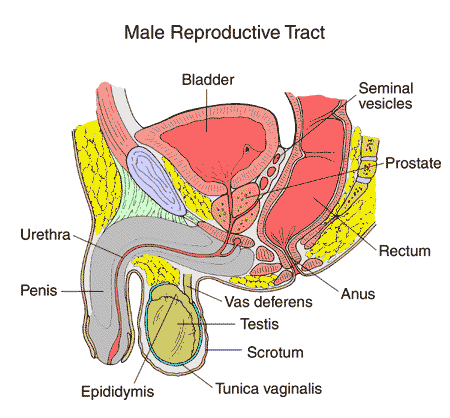
Anus: The opening at the end of the digestive tract where bowel contents leave the body.
Bladder: A triangular shaped, hollow organ located in the lower abdomen. It is held in place by ligaments that are attached to other organs and the pelvic bones. The bladder's walls relax and expand to store urine and contract and flatten to empty urine through the urethra.
Epididymis: A long tube that is located near each testicle. The epididymis is the tube in which the sperm from the testicles are removed away from the testicles.
Penis: The external reproductive organ of the male. The penis is made up of two parts, the shaft and the glans. The glans is the tip of the penis, while the shaft is the main part of the penis and contains the tube (urethra) that drains the bladder. All boys are born with a foreskin, or a covering over the tip of the penis. Some boys are circumcised, which means that this covering of skin is removed. Other boys are not circumcised and may have skin that covers the tip of the penis.
Prostate gland: A sex gland in men. It is about the size of a walnut and surrounds the neck of the bladder and urethra — the tube that carries urine from the bladder. It is partly muscular and partly glandular with ducts opening into the prostatic portion of the urethra. It is made up of three lobes: a center lobe with one lobe on each side. The prostate gland secretes a slightly alkaline fluid that forms part of the seminal fluid, a fluid that carries sperm.
Rectum: The lower end of the large intestine, leading to the anus.
Scrotum: The bag of skin that holds and helps to protect the testicles. The testicles make sperm and, to do this, the temperature of the testicles needs to be cooler than the inside of the body. This is why the scrotum is located outside of the body.
Seminal vesicles: The sac-like glands that lie behind the bladder and release a fluid that forms part of semen.
Testes (testicles): The testes are two small organs that are found inside the scrotum. The testes are responsible for making sperm and are also involved in producing a hormone called testosterone. Testosterone is an important hormone during male development and maturation — for developing muscles, deepening the voice and growing body hair.
Urethra: The tube that allows urine to pass outside the body. The brain signals the bladder muscles to tighten, which squeezes urine out of the bladder. At the same time, the brain signals the sphincter muscles to relax to let urine exit the bladder through the urethra. When all the signals occur in the correct order, normal urination occurs.
Vas deferens: A tube that carries the sperm out of the scrotal sac. The vas deferens is between the epididymis and the urethra and connects these together.



